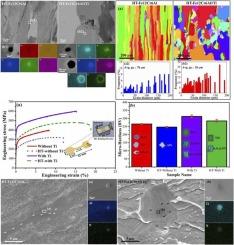在激光粉末床熔合过程中加入Ti提高了Fe12Cr6Al的高温稳定性
IF 6.3
2区 材料科学
Q2 CHEMISTRY, PHYSICAL
引用次数: 0
摘要
本研究探讨了热处理(1200℃-1h)对激光粉末床熔合(LPBF)制备的Fe12Cr6Al合金(含ti和不含ti)中各种原位合成氮化物和氧化物析出物的影响。进一步分析了原位合成析出物Al2O3、AlN- o、AlN、AlTi-N、TiN和TiN@Al2O3对不含ti和含ti试样热处理前后组织和力学性能的影响。热处理前,不含ti的样品中含有Al₂O₃、AlN-O、AlN纳米沉淀;然而,处理后只剩下AlN纳米沉淀。相比之下,含ti样品在热处理后AlTiN析出相转变为TiN和TiN@Al₂O₃析出相。晶粒尺寸分析显示,未添加ti的样品从71 μm增加到76 μm,而添加ti的样品从12 μm增加到26 μm。AlN纳米相的尺寸从33 nm增加到84 nm, TiN纳米相的尺寸从57 nm增加到93 nm。机械上,热处理降低了两种样品的屈服强度(YS)和极限抗拉强度(UTS)。不含ti样品的YS和UTS分别下降了约36%和19%,而含ti样品的YS和UTS分别下降了约28%和20%。尽管有这些降低,但伸长率有所提高,在不含ti的样品中增加了3.5%,在含ti的样品中增加了4%。维氏硬度(HV)也有所下降,无ti样品降低约7%,含ti样品降低约10%。本研究为Fe-12Cr-6Al合金热处理过程中氮化物和氧化物纳米沉淀物的演变及其对合金性能的影响提供了全面的见解,为现有文献提供了宝贵的知识。本文章由计算机程序翻译,如有差异,请以英文原文为准。

Improved High Temperature Stability of Fe12Cr6Al by adding Ti during Laser Powder Bed Fusion
This study explores the effects of heat treatment (1200 °C-1h) on various in-situ synthesized nitride and oxide precipitates in Fe12Cr6Al alloys, without and with-Ti, produced via Laser Powder Bed Fusion (LPBF). Furthermore, the impact of the in-situ synthesis precipitates such as Al2O3, AlN-O, AlN, AlTi-N, TiN, and TiN@Al2O3 on the microstructure and mechanical properties of samples without-Ti and with-Ti was analyzed before and after heat treatment. Before heat treatment, the without-Ti sample contained Al₂O₃, AlN-O, and AlN nano-precipitates; however, only AlN nano-precipitates remained post-treatment. In contrast, the with-Ti sample exhibited a transformation of AlTiN precipitates into TiN and TiN@Al₂O₃ precipitates after heat treatment. Grain size analysis revealed a modest increase in the without-Ti sample, from 71 μm to 76 μm, whereas the with-Ti sample showed an increase from 12 μm to 26 μm. Additionally, the size of AlN nano-precipitates increased from 33 nm to 84 nm, while TiN nano-precipitates grew from 57 nm to 93 nm. Mechanically, heat treatment reduced the yield strength (YS) and ultimate tensile strength (UTS) of both samples. YS and UTS decreased by approximately 36% and 19% for the without-Ti sample, respectively, while the reductions were around 28% and 20% for the with-Ti sample. Despite these decreases, elongation improved, increasing by 3.5% in the without-Ti sample and by 4% in the with-Ti sample. The Vickers hardness (HV) also declined, with reductions of approximately 7% for the without-Ti sample and 10% for the with-Ti sample. This study offers comprehensive insights into the evolution of nitride and oxide nanoprecipitates during heat treatment and their influence on the properties of the Fe-12Cr-6Al alloy, contributing valuable knowledge to the existing literature.
求助全文
通过发布文献求助,成功后即可免费获取论文全文。
去求助
来源期刊

Journal of Alloys and Compounds
工程技术-材料科学:综合
CiteScore
11.10
自引率
14.50%
发文量
5146
审稿时长
67 days
期刊介绍:
The Journal of Alloys and Compounds is intended to serve as an international medium for the publication of work on solid materials comprising compounds as well as alloys. Its great strength lies in the diversity of discipline which it encompasses, drawing together results from materials science, solid-state chemistry and physics.
 求助内容:
求助内容: 应助结果提醒方式:
应助结果提醒方式:


